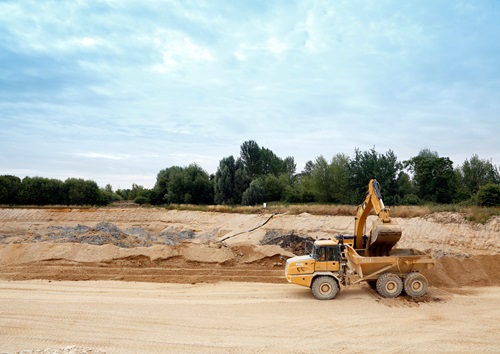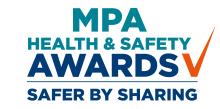How dangerous is Quarrying?
It’s important to state that the industry has and is doing a great deal to avoid accidents and injuries. The British Aggregates Association’s Scheme for Assessing Operating Standards is a good example. It’s a system that should be lauded for taking ownership of accidents in a manner that seeks continuous improvement.
This approach has worked well in the aviation industry, with its long history of sharing accident information from black box recordings. The objective is to seek improvement rather than find blame. Chesley Sullenberger, the pilot who safely landed his plane on the Hudson River in New York, said: "Everything we know in aviation, every rule in the rule book, every procedure we have, we know because someone somewhere died... We have purchased at great cost lessons we have to preserve and pass on to succeeding generations."

Sadly, accidents and injuries in quarries are still happening - at a rate higher than other comparable industries, such as construction. The most recent reports show that the fatality rate per 100,000 workers is still relatively high. Part of the reason is how comparisons are made – fewer people work in quarries, so the rate per hour worked is high. According to HSE statistics, from 2000 to 2021, over 3,500 workers suffered an injury reportable to HSE, with 31 of those being fatal. The main causes of occupational injury and ill health in the quarry industry are falls from heights, transport, slips and trips, hand-arm vibration, asthma, noise, silica and explosives.
The need to learn from the dangers of quarrying has been brought into sharp focus at one quarry in Leicestershire. In 2002, Keith Branston was killed, and the quarry fined £200,000 plus costs. Some 15 years later, his great-nephew also lost his life at the same quarry. As a result, Tarmac was fined £1.275m plus costs in September 2023.
In summary these tragic events prove that health and safety is a constant process of improvement with no place for complacency.
What are your responsibilities?
Let’s first consider what the law says about the duty of care. It is “the duty of every employer to ensure, so far as is reasonably practicable, the health, safety and welfare of all his employees whilst they are at work”.
Importantly, employers are expected to provide the necessary information, instruction, training and supervision to ensure, so far as is reasonably practicable, employees' health, safety and welfare. This also extends to third parties and the public.
Falling foul of these duties and breaking the law can lead to criminal and civil cases, fines and imprisonment.
Legislation changed in 2015, increasing prison sentences to a maximum of two years in Magistrates’ Courts and fines from £5,000 to unlimited amounts in England and Wales. The rationale is to encourage the greater use of fines in the Magistrates’ Courts and to make them proportionate to the company's size. It is reasonable to expect fines to grow sharply. Importantly, no incident is necessary, and prosecution is based on the risk of harm.
Sanctions are not just limited to the judicial process. The introduction of Fee for Intervention (FFI) fines also needs to be addressed. Not least, as they are cumulative until the issue is resolved. The HSE regularly posts bulletins highlighting offenders. A recent example saw a construction firm £20,000 for a ‘catalogue of failings’.
Corporate manslaughter has been an offence since 2008. It is concerned with corporate liability rather than those of the directors or other individuals who have a senior role in the company. That said, existing health and safety offences and gross negligence manslaughter still apply. There can be prosecutions against individuals where there is sufficient evidence.
In the event of a fatality, the human tragedy is impossible to estimate for the family, the friends and the firm involved. From a legal perspective, the penalties include unlimited fines and publicity orders. There are many examples where the courts have required firms to publicise that they have been convicted, giving the details and the fine imposed. As Warren Buffet said: "It takes 20 years to build a reputation and five minutes to ruin it. If you think about that, you'll do things differently."
Directors can also be held personally responsible. The Institute of Directors recommends that directors protect themselves against the risks they face in their roles. Claims or proceedings against directors or officers can arise from any decision made or act carried out in the workplace. Also, whilst it is clear who a director is, an officer can encompass a range of key senior managers. It is no surprise then that we find this area of risk and insurance is one that directors take a keen interest in. We always recommend that you discuss this in detail with your insurance broker.
Building a safe business environment
Quarry firms need to analyse if they are doing all they can to demonstrate their actions to address potential health and safety hazards.
You should build your strategy around evidence, evidence and evidence.
Evidence that you take a proactive approach- raising awareness about health and safety will reduce the number of incidents.
Evidence that you have robust processes – develop a sound system of record-keeping to provide evidence to defend against prosecutions.
So, what are the practical steps you need to take?
Build a culture where everybody understands the importance of recording health and safety actions. Without this, everything else is in danger of being a tick-box exercise. Conduct a thorough risk assessment and employ a safe system of work based on this.
Keep records. Good record-keeping can improve an organisation’s ability to defend itself against claims and prosecutions. These should always include names, dates and signatures. Keep records of statutory inspections as well as accident reports and CCTV evidence.
Training is more than a course. If your staff have been given risk management training on a specific topic, records of the training should include not just the names of the employees and the date of the training but also details about what the training involved.
If you want to go further, perhaps engage with a specialist firm. For example, we have helped with the above and conducted health and safety audits supported by claims trend analysis to identify key risks. We can also recommend employee and manager debrief forms, industry standards, accompanied insurer surveys and impromptu walk-rounds.
Defending yourself if the worst happens
We all hope that a claim will never happen, but there would be no insurance market if that were the case. Ensuring your business is back on track becomes even more important if there is an accident or injury.
In the event of a claim, it’s important to tell your insurer immediately, the same day if possible. This first notification of loss means that insurers can take proactive measures such as private medical care, advice, recovery care and post-incident support to get the injured party back on their feet. It also means that you can put yourself in control of the situation, getting in before the ‘ambulance chasers’ and fees start to mount up. It’s a benefit to your employees as well as to you.
Risk management can help prevent insurance premium increases
The legal, moral and ethical business needs to reduce risk are clear. There is another upside. A structured risk management and health and safety programme will make quarry firms more attractive to insurance companies. Insurance companies also encourage cultural improvements as part of a robust management programme.
There is a straight-line link between the risk management and health and safety procedures a client has in place and the long-term premiums they pay. This evidence of higher standards and improvement initiatives is powerful when placing your risk. These can present you in a favourable light – and affect your premium and terms and conditions. With the right systems, you can reduce the chances of a claim and the premiums you pay in the longer term.
Our advice to clients is to have the right amount of cover to reflect the size and shape of their business. However, the starting point has to be prevention rather than cure. Insurance should be the last line of defence, not the first.
Simon Cutmore is the Director of Risk Management at Verlingue UK. He is a Fellow of the Chartered Insurance Institute, a Certified Fellow of the Institute of Risk Management and a Chartered Safety and Health Practitioner. Simon has worked in Risk Management for over 20 years.









